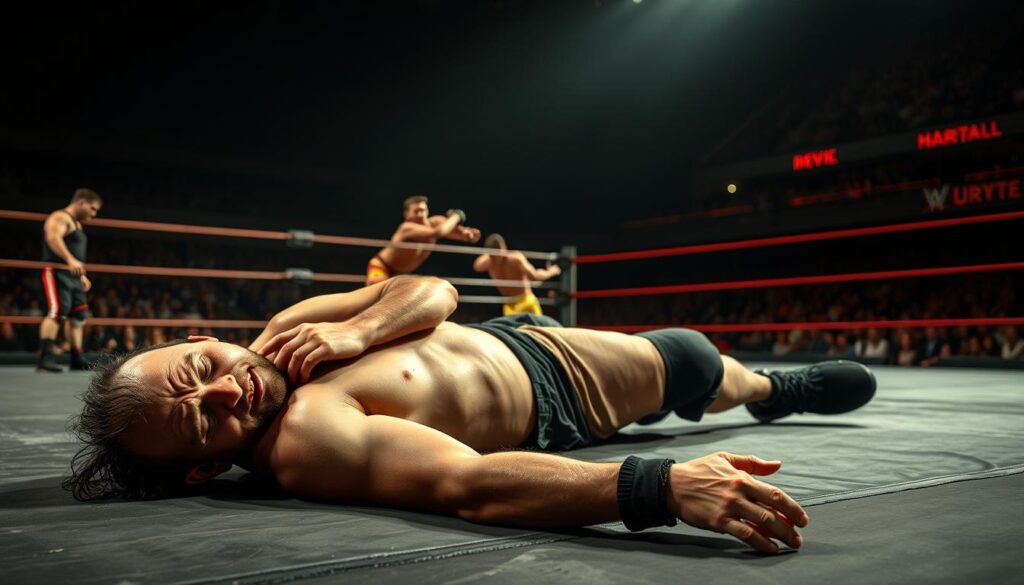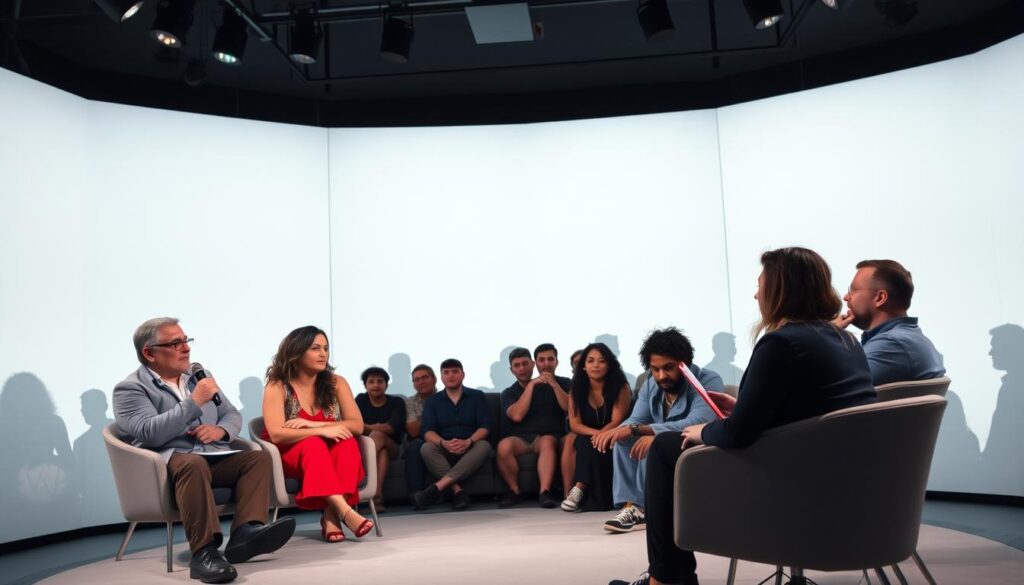What if I told you those “fake!” chants reveal more about human psychology than athletic theater? We’ve all stood at this crossroads – where Hulk Hogan’s leg drop collides with Aristotle’s three-act structure. Mick Foley’s barbed wire epiphanies debate Plato’s cave allegory.
This isn’t about defending body slams or steel chairs. It’s about why a Greek chorus of fan questions echoes through arenas decades after Vince McMahon admitted the truth. When The Rock raised an eyebrow, he wasn’t just breaking the fourth wall – he was rewriting its blueprint.
Consider Andre the Giant’s shadow. At 7’4″, his presence defied physics, yet we argued about “real” rivalries. Our collective suspension of disbelief mirrors society’s dance with truth – from political theater to TikTok dramas. The squared circle’s secret? It winks while delivering suplexes.
Through Q&A frameworks used by ancient philosophers and modern fact-checkers alike, we’ll dissect everything from “pre-determined” accusations to why Macho Man’s promos belong in the MoMA. Prepare for revelations sharper than Stone Cold’s middle fingers.
Why Myths Persist
Why do we need to believe Andre the Giant was 7’4″? It’s like pretending Hamlet’s ghost isn’t real during the play. Wrestling’s pro wrestling misconceptions are like modern myths. They fill our need for stories, and the confusion is key.
Kayfabe is like wrestling’s fourth wall, but it’s made of funhouse mirrors. Unlike Marvel movies, where everyone knows Chris Evans isn’t 106, wrestling asks us to know and play along. It’s like a mix of Nietzsche’s eternal recurrence and Monday Night Raw, with endless cycles of heroes and villains.
Let’s look at what makes these myths:
- Scaled reality: Andre’s “7’4″ stature” (actually 6’10”) became a big story through constant telling
- Plausible deniability: When Hulk Hogan body-slammed Andre at WrestleMania III, everyone was in on it
- Cultural crossover: The Princess Bride’s Fezzik didn’t make Andre’s myth smaller – it made it bigger
This mix turns wrestlers into characters from Joseph Campbell’s stories. The Rock isn’t just Dwayne Johnson; he’s a hero with a thousand smiles. John Cena’s “underdog” story? It’s the Monomyth’s refusal to end, even when we all know the story.
The magic of wrestling is its collaborative deception. We pretend not to know it’s staged, like at Hamilton. But here, we can also shout “BULLSHIT!” at the bad guy. It’s not about not knowing it’s staged. It’s about enjoying the show, making every slam a test of our love for big stories.
Myth 1: “It’s All Fake”
Let’s tackle the “it’s fake” myth head-on. When Daniel Bryan collapsed at WrestleMania 30, his tears were real. His career-ending concussion was just as real. Scripted outcomes don’t change the broken bones, torn ligaments, or chronic pain wrestlers face. This is professional wrestling, a mix of art and athleticism where every move has a cost.
Kabuki theater has set stories, but the performers’ skill is real. Is Hamilton “fake” because Lin-Manuel Miranda wrote the lines? No, it’s crafted. Wrestling blends choreography with quick thinking. Shawn Michaels didn’t just “fall” off ladders; he made every move count to make you feel his pain. That’s not fake—it’s emotional engineering.
The term “fake” is misleading. Wrestling openly says it’s fictional. The real magic is in the execution: 250-pound athletes trust each other to simulate violence safely. Yet, accidents can happen—just ask Mick Foley about that Hell in a Cell match. Calling wrestling fake insults the performers’ skill and the audience’s smarts. It’s like saying Picasso was a fraud for using brushes.
Wrestling’s physical toll is similar to contact sports. NFL players get praised for “toughing it out.” Why don’t wrestlers get the same respect? Next time someone says it’s fake, ask: Would they take a Tombstone Piledriver on a Monday night?
Myth 2: “Wrestlers Don’t Get Hurt”
Let’s debunk this myth like Mick Foley through an announcer’s table. The idea that wrestlers don’t get hurt is as real as a superhero movie’s stunt double doing all the flips. Injury reports show 82% of wrestlers suffer serious damage, more severe than ECW’s infamous “Mass Transit Incident.”
Darren “Droz” Drozdov got paralyzed in 1999 from a neck injury. Sasha Banks had to leave in 2022 due to spinal trauma. These aren’t just storylines but real injuries from wrestling 250+ nights a year.
| Era | Injury Rate | Notable Cases | Policy Changes |
|---|---|---|---|
| Attitude Era (1997-2002) | 67% | Steve Austin’s neck fusion | No blood restrictions |
| Ruthless Aggression (2002-2008) | 58% | Edge’s spinal stenosis | Chair shot bans |
| PG Era (2008-2014) | 49% | Daniel Bryan’s concussions | WWE Wellness Policy |
| Current Era (2014-present) | 41% | Paige’s early retirement | Reduced high spots |
Women’s wrestling shows the danger is not just for men. Chyna’s 2001 neck injury almost ended her career. Today, stars like Mercedes Moné (fka Sasha Banks) deal with injuries and pain, not just glamour.
- Mickie James: Torn ACL during 2020 Empty Arena Match
- Beth Phoenix: Cracked sternum from 2007 SummerSlam bump
- Jamie Hayter: Separated shoulder during 2023 All Out
Modern wrestling is a paradox. Dr. Jeffrey Amann’s skills save careers, but the WWE Wellness Policy can’t undo past damage. Today’s matches are as demanding as 80s cartoon wrestling, with risks as high as a ladder match.
So, next time someone says “they’re just pretending,” ask: When did your job last require emergency surgery after a stunt?
Myth 3: “Matches Are Improvised”
If wrestling were truly improvised, we’d see more mistakes than a middle school talent show. But, matches are carefully planned stories – like Hamilton with body slams. Let’s look at the hidden work behind what fans think is “on-the-fly storytelling.”
Modern wrestling uses an agent system made famous by legends like Pat Patterson. His plan for the first Royal Rumble (1988) was groundbreaking. It turned chaos into drama. Agents act like Broadway directors:
- Planning key “spots” (high-impact moments)
- Timing commercial breaks for big moments
- Controlling crowd reactions with pacing
Lucha libre’s llaveo sequences are like jazz improvisation. Mexican wrestlers practice 50-100 set exchanges, then improvise within those limits. It’s not completely free – it’s structured creativity, like Coltrane playing over chord changes.
| Style | Planning Depth | Improvisation Allowance |
|---|---|---|
| WWE Main Event | Minute-by-minute scripting | 5% (safety adjustments) |
| Lucha Libre | Pre-set sequences | 15% (timing variations) |
| Japanese Strong Style | Broad story beats | 25% (stiffness adjustments) |
The Okada/Omega trilogy (2016-2018) shows this balance. Their 7-star Tokyo Dome match had:
- 32 planned major spots
- 7 improvised counters to crowd reactions
- 3 emergency adjustments for blood loss
Even “botches” are used. In a 1992 match, a near-end came 10 minutes early. Gorilla Monsoon shouted “ROPE BREAK!” through the headset, creating a new finish. It was not improv – it was crisis management.
Q&A Spotlight: “Do wrestlers ever truly wing it?” Only in emergency situations – like adjusting for injuries mid-match. But even then, they use mental libraries of 500+ rehearsed sequences. It’s not spontaneity – it’s selective recall.
More Myths and Truths
The rumor mill in wrestling is like a never-ending battle. Every myth has a truth waiting to knock it down. This isn’t just in America—it’s a global phenomenon.
Myth: “Wrestlers can’t act.” Dwayne Johnson and John Cena have proven this wrong. Batista’s role in Blade Runner 2049 even stunned critics.
The idea that wrestling is only for kids is outdated. The Attitude Era had ratings as high as Friends. Wrestling has been a part of our culture for years, from cartoons to late-night shows.
The claim that women can’t main event is false. Becky Lynch’s WrestleMania 35 drew huge crowds. Ronda Rousey and Charlotte Flair have also shown their skills.
Wrestling changes like kayfabe itself. In Japan, matches are like samurai battles. Lucha Underground mixed drama with death-defying stunts. In India, wrestling grew 300% after The Great Khali’s WWE stint.
The “Goldberg squashed jobbers” myth has a point. Those quick matches were part of a bigger story. They showed the power of controlled chaos, even inspiring TikTok creators.
Wrestling is more than just fake—it’s designed. It’s not childish—it’s archetypal. And it’s not just for one country—it’s a global story, told in many ways.
Fan-Sourced Questions Answered
You’ve shouted questions at the screen like Stone Cold chugging beers – now let’s unpack them with forensic enthusiasm. We looked through forums, Twitter threads, and arena chatter to answer your wrestling questions. No corporate spin, just the raw truth served hotter than a Hell in a Cell match.
“Why don’t tag partners interfere during matches?” Great question! It’s all about wrestling’s unspoken rulebook. Lucha libre allows constant interference (chaos is the point), while WWE treats tag matches like procedural dramas – partners must stay on the apron unless tagged. Think of it as the difference between a mosh pit and a courtroom.
Theme song mysteries? Let’s break it down like a Chris Jericho codebreaker:
- WWE’s former music team CFO$ crafted tracks using wrestler personas as blueprints (e.g., Nakamura’s violin-heavy entrance)
- Legends like Jericho sometimes self-fund iconic themes – he paid $15k out-of-pocket for “Judas”
- Survivor Series 2021 proved music’s power – fans sang “Judas” louder than pyro explosions
Merchandise inquiries reveal billion-dollar secrets. Stone Cold’s “3:16” shirts sell $2M annually – that’s Cam Newton-level NFL merch numbers without the draft drama. Today’s stars use limited drops and pop-up shops, turning tees into collector’s items faster than you can say “Money in the Bank.”
And to the fan who asked “Do wrestlers keep their championship belts?” – sometimes. WWE typically reclaims titles, but legends occasionally negotiate keepsakes. It’s like getting to keep the Stanley Cup… if Bettman ran a scripted sport.
Cultural Roots of Misconceptions
Wrestling myths aren’t just in the ring. They come from our society’s deep-seated fears. From Plato’s cave to CM Punk’s “pipe bomb” promo, we mix showmanship with deceit. Wrestling shows us our fears about gender, class, and being real.
Andy Kaufman’s 1980s matches were seen as shock comedy. But they were actually a commentary on gender and power. Kaufman’s acts didn’t just break the illusion; they showed our discomfort with reality.
Hollywood often spreads pro wrestling misconceptions. Darren Aronofsky’s The Wrestler lost to Slumdog Millionaire in 2009. It was more than just an Oscar loss; it was art turning away from itself. Aronofsky’s story was inspired by Gorgeous George, but critics saw wrestling as lowbrow.
| Cultural Movement | Wrestling Parallel | Public Perception Gap |
|---|---|---|
| Beatlemania (1960s) | Hulkamania (1980s) | Music = art vs. Wrestling = carnival |
| Reality TV Boom (2000s) | ECW’s Hardcore Revolution | Scripted = innovative vs. Scripted = fake |
| #MeToo Era | Women’s Evolution (WWE) | Progress celebrated vs. Progress questioned |
Wrestling’s self-parodies show us uncomfortable truths. WWE’s Southpaw Regional Wrestling series is a loving look back. But it also shows why fans doubt today’s wrestling. The more “real” it tries to be, the more we want the fake.
These myths stick because wrestling makes us face our own performances. We see a politician’s speech as real but not Ric Flair’s. The only difference is the outfit.
Kayfabe’s Historical Role
Kayfabe isn’t dead; it’s just playing a trick on us. It started as a secret in carnivals and now it’s like a Marvel Studios scene. Everyone knows it’s fake, but we love the story.
The Montreal Screwjob was a big deal in wrestling. It showed that wrestling had to change in 1997. It moved from secrets to audience-collaborative storytelling. This is like Marvel’s way of dealing with spoilers.
Today, kayfabe works in three ways:
| Era | Kayfabe Expression | Cultural Mirror |
|---|---|---|
| Carnival Days (1920s-80s) | Literal secrets guarded like nuclear codes | Vaudeville illusions |
| Attitude Era (90s) | “Reality” bleeding into scripts | Emergence of reality TV |
| Social Media Age | Fans dictating storylines via tweets | Marvel spoiler arms race |
Political strategists could learn from the Young Bucks. Their YouTube series, Being the Elite, mixes real and fake. It’s like a game where fans look for clues in every video.
MMA also plays with kayfabe. Conor McGregor’s trash talk and Dana White’s persona are all part of the show. But wrestling fans know it’s all a joke.
So, when you see a politician or a TikTok star acting fake, remember. We’re all part of kayfabe’s world now. The lines between reality and show have blurred.
Conclusion
When the lights go up and the last firework ends, wrestling myths and fan questions come to light. Bret Hart’s exit in Calgary was more than a retirement; it was a show that echoed ancient stories. The Undertaker’s undefeated streak at WrestleMania? It was like Hercules finishing his tasks in wrestling clothes.
Joseph Campbell’s idea of the monomyth is seen in every wrestling move. When Ric Flair shouted “Woo!” at Starrcade ’83, he tapped into deep human feelings. But we wonder, like Roland Barthes did with Mythologies, why we see wrestling as fake but art as real.
Fans questioning scripted outcomes miss the point. Mick Foley’s fall from the Hell in a Cell match left a mark on the Spanish announce table. It was like Shakespeare risking his head for drama. Next time someone says it’s all planned, ask if they check their horoscope.
The truth in wrestling is in the mix of real and fake. It’s the balance between the scripted and the real athleticism. The show isn’t a lie; it’s a call to watch more closely. It’s time to stop asking if it’s real and start asking if it matters.


